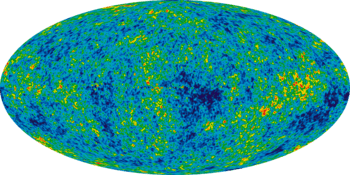Photon epoch
| Part of a series on | |||
| Physical cosmology | |||
|---|---|---|---|
 | |||
|
Early universe
|
|||
|
Components · Structure |
|||
| |||
In physical cosmology, the photon epoch was the period in the evolution of the early universe in which photons dominated the energy of the universe. The photon epoch started after most leptons and anti-leptons were annihilated at the end of the lepton epoch, about 10 seconds after the Big Bang.[1] Atomic nuclei were created in the process of nucleosynthesis which occurred during the first few minutes of the photon epoch. For the remainder of the photon epoch the universe contained a hot dense plasma of nuclei, electrons and photons. 379,000 years after the Big Bang the temperature of the universe fell to the point where nuclei could combine with electrons to create neutral atoms. As a result, photons no longer interacted frequently with matter, the universe became transparent and the cosmic microwave background radiation was created and then structure formation took place.
See also
References
- Allday, Jonathan (2002). Quarks, Leptons and the Big Bang (Second ed.). Institute of Physics Publishing. ISBN 978-0-7503-0806-9.